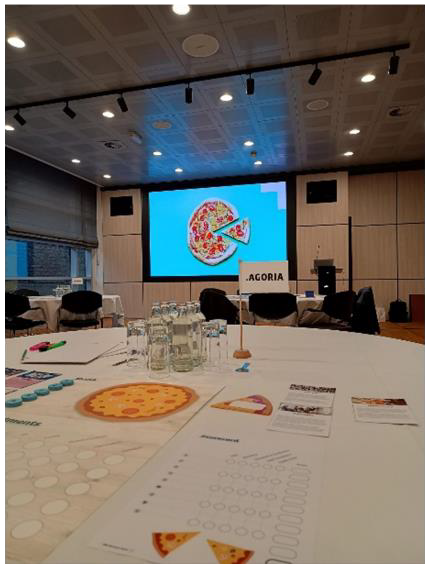Short instruction
Modern life is not possible without standards that are present all around us. You can plug all the electrical products you buy into the same socket, and each TV will receive a signal from the local broadcaster. To replace tyres on a car, you only need to know the marks – all manufacturers produce tyres following the dimensions and marking standards.4 At the same time, on the market full of products manufactured following the standards, it is possible to find many products of different quality, classes or types. Product standards do not define all product characteristics but only some important for the market. Imagine how good it would be if every cartridge fit every printer, regardless of manufacturer, just like you can buy printing paper from any manufacturer. There are plenty of varieties in their quality and prices, but they are all in the same format. All of them are in A4 format, which, like other A and B formats, was first defined by the DIN 476 standard, published in 1922. Welcome to the world of standardisation, where much work is still to be done (Mijatović, 2019).
There are plenty of examples which show the strategic importance of standards and standardisation in fostering economic growth, innovation, and global competitiveness, enhancing quality, safety, interoperability, and compatibility, and enabling access to the global market usually by reducing technical trade barriers.
According to the ETSI (2024), key reasons why it is important to teach the strategic importance of standardisation are:
- Economic Competitiveness: Standardisation is a key driver of economic competitiveness. By adhering to recognized standards, industries enhance product quality, reduce costs, and streamline processes. Educating the workforce about these standards ensures that businesses remain globally competitive and can participate actively in international trade.
- Innovation and Research: Standardisation fosters innovation by providing a common framework for the development and implementation of new technologies. A well‐educated population is better equipped to engage in research and development activities that adhere to established standards, contributing to technological advancements and breakthroughs.
- Consumer Protection: Standardisation is crucial for ensuring the safety and quality of products and services, this includes the ever‐increasing threats due to Cyber security. Educating consumers about the significance of standards empowers them to make informed choices, protecting their interests and fostering trust in the marketplace.
- Global Trade Facilitation: International trade relies on standardized practices to ensure smooth cross‐border transactions. By educating the workforce about global standards, businesses are able to seamlessly integrate into the international market, fostering economic growth and diplomatic relations.
- Environmental Sustainability: Standards play a vital role in promoting sustainable practices and mitigating environmental impact. Integrating education on environmental standards prepares our citizens to contribute to sustainable development and address global challenges, such as climate change.
The ILOs examples
K6.1., K7.1., S6.6., S7.3.
Recommended Teaching Case studies/Serious games/Оther
1. Standards Are All Around You: Electronic Posters & Graphics (American National Standards Institute – ANSI)
The electronic posters and graphical presentations are freely downloadable from the ANSI’s official website and can be used in introductory classes to raise awareness about technical solutions offered in standards – “Though hidden from sight in everyday life, standards are truly everywhere, working behind the scenes to assure that we can live, learn, play, and work safely and efficiently. Check out some of the places you can find standards”.
To learn more about ANSI’s electronic posters and graphics, please visit the following link: https://www.ansi.org/education/activities/standards-student-programs/k-12-students
2. Standardisation Serious Game: IdeaMania (CEN)
Keywords: Standardisation, Standards
About: IdeaMania is online game aimed at increasing attention and awareness of standardisation, get target group interested in standardisation, improve impression of target groups to be favourable toward standardisation
Details:
Time to play: 3 - 5min per level, 3 levels (Level 1: wind energy plant maintenance service Level 2: parcel box for postal services, Level 3: chemical exposure models
Target group: researchers, startups, spinoffs
Contact: christian.goroncy@din.de
Background: Created within BRIDGIT 2 (Bridging the Gap between Research & Standardisation)

3. Standardisation Serious Game: NBN Business Game
Keywords: Standardisation in the context of product development.
About:
The aim of the NBN Business Game is to get to know the value of standards in a broader context. The main context of the game is based on forging the ideal investment plan, creative tasks, teamwork, maximizing shareholder value, fun and reflection on the value of standards.
Details:
- To be played in groups of 2-5, max. 5 groups
- 60 min game + 30 min reflection
- Available in English
- Contact: yens.van.overloop@nbn.be
Background: Hosted by NBN

Good practice
The introduction of standardisation and standards might be a complex task, and starting with definitions might be confusing. Explanation of the presence of standards (and effects of their implementation, application or use) and their strategic importance in different contexts (e.g., for technological advancements, market creation etc.) can raise interest in the topic and enhance chances for understanding the meanings of standardisation and standards.
Recommended sources
- Abdelkafi, N., Bekkers, R., Bolla, R., Rodriguez-Ascaso, A., & Wetterwald, M. (2021). Understanding ICT Standardisation: Principles and Practice, ETSI 2021, URL: https://www.etsi.org/images/files/Education/Textbook_Understanding_ICT_Standardisation.pdf, 2nd Edition, Chapter 8.
- de Vries, H. J. (1999). Standardisation: A Business Approach to the Role of National Standardisation Organizations. Springer Science+Business Media, LLC. https://www.springer.com/gp/book/9780792386384.
- Hesser, W., Feilzer, A., & de Vries, H. J. (2010). Standardisation in Companies and Markets. Helmut Schmidt University. https://www.researchgate.net/publication/337160610_Standardisation_in_Companies_and_Markets_3rd_Ed.
- Spivak, S., & Brenner, C. (1993). Standardisation Essentials: Principles and Practice
(First edition). CRC Press. https://doi.org/https://doi.org/10.1201/9781482277388. - Grillo, F., Wiegmann, P.M., de Vries, H.J., Bekkers, R., Tasselli, S., Yousefi, A., van de Kaa, G. (2024). Standardisation: Research Trends, Current Debates, and Interdisciplinarity. Academy of Management Annals, 18(2), 788-830.
- Akerlof, G. A. (1970). The Market for “Lemons”: Quality Uncertainty and the Market Mechanism. The Quarterly Journal of Economics. https://doi.org/10.2307/1879431.
- Montiel, I., Husted, B. W., & Christmann, P. (2012). Using private management standard certification to reduce information asymmetries in corrupt environments. Strategic Management Journal, 33(9), 1103-1113.
- Nagurney, A., Li, D., & Nagurney, L. S. (2014). Spatial price equilibrium with information asymmetry in quality and minimum quality standards. International Journal of Production Economics, 158, 300-313.
- Teece, D.J. (2018). Profiting from innovation in the digital economy: Enabling technologies, standards, and licensing models in the wireless world. Research Policy, 47(8), 1367-1387.